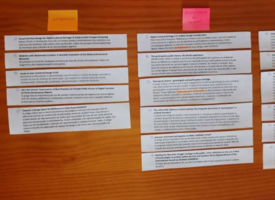Design of search interfaces for digital cultural collections platforms: a set of UX recommendations
A disponibilização de acervos culturais de bibliotecas, arquivos e museus em plataformas no ambiente digital democratiza o acesso ao conteúdo e apresenta diversas vantagens, como a consulta aos documentos por vários usuários ao mesmo tempo e sem restrições geográficas. Entretanto, os usuários são expostos a um processo de busca pela informação, que pode ser dificultado, quando não possuem domínio de conhecimento sobre os acervos culturais ou as ferramentas de acesso, da mesma forma que os profissionais da área e o público especializado. O envolvimento do usuário com a plataforma interfere no acesso e por conseguinte na fruição e nouso dos acervos. Desta forma, é necessário o direcionamento com foco no usuário, o que acaba por exigir que os projetos e melhorias das plataformas digitais sejam empreendidos levando-se em conta, além das questões tecnológicas e da organização da informação, o engajamento dos usuários e a compreensão do que é importante para eles. A partir do exposto, portanto, entende-se que estas plataformas requerem qualidades próprias e neste sentido, o presente estudo teve por objetivo configurar recomendações projetuais para o desenvolvimento de interfaces de pesquisa de plataformas de acesso a acervos culturais de instituições de memória, com foco na experiência do usuário não especialista, tendo em vista relações entre os escopos do Design, do patrimônio cultural e da busca digital de informações. Como abordagem metodológica, foi utilizado o estudo de caso associado a Design Science Research, constituída de quatro fases: compreensão, proposição, avaliação e conclusão. Como resultado, obteve-se um conjunto configurado, organizado e validado em onze categorias e trinta e duas recomendações projetuais, a partir da literatura científica sobre o tema, da análise de como plataformas de referência possibilitam a busca e recuperação da informação e da escuta do ponto de vista de especialistas em acervos e do público não especialista. Como contributos adicionais figuram: a relação dos fatores que afetam a experiência do usuário, o método e o modelo descritivo para o desenvolvimento de personas e as personas representativas de usuários reais dos acervos culturais da Fiocruz. Acredita-se que este conjunto de recomendaçõespossa contribuir para o aprimoramento dos produtos digitais que são seu objeto de estudo, a partir de uma visão global e estruturada deste tipo de artefato e que possa ser utilizado pelas instituições culturais no embasamento da tomada de decisão em seus projetos de difusão de acervos no meio digital. No âmbito acadêmico, espera-se contribuir com a literatura sobre design de experiência no contexto do patrimônio cultural no meio digital. Este é um tema recente, socialmente relevante, que vem sendo debatido dentro das instituições culturais e que ainda carece de estudos, que fomentem a discussão sobre a importância de entender o modelo mental dos usuários, que agora convivem com um mundo cada vez mais digital e virtual.
Making the cultural collections of libraries, archives and museums available on platforms in the digital environment democratises access to the content and has several advantages, such as several users being able to consult the documents at the same time and without geographical restrictions. However, users are exposed to a process of searching for information, which can be difficult when they don't have a command of knowledge about cultural collections or access tools, in the same way as professionals in the field and specialised audiences. The user's involvement with the platform interferes with access and therefore the enjoyment and use of the collections use of the collections. As such, it is necessary to focus on the user, which ultimately requires that projects and improvements to digital platforms be undertaken taking into account, in addition to technological issues and the organisation of information, the engagement of users and an understanding of what is important to them. Based on the above, it is understood that these platforms require their own qualities and, in this sense, the aim of this study was to set out design recommendations for the development of search interfaces for platforms to access cultural collections in memory institutions, focusing on the experience of non-specialist users, taking into account the relationship between the scopes of design, cultural heritage and digital information search. The methodological approach used was a case study associated with Design Science Research, consisting of four phases: understanding, proposition, evaluation and conclusion. The result was a set of eleven categories, organised and validated, and thirty-two design recommendations, based on the scientific literature on the subject, an analysis of how reference platforms enable the search for and retrieval of information, and listening to the point of view of experts in collections and the non-specialist public. Additional contributions include: the list of factors that affect the user experience, the method and descriptive model for developing personas and the personas representing real users of Fiocruz's cultural collections. It is believed that this set of recommendations can contribute to the improvement of the digital products that are its object of study, based on a global and structured vision of this type of artefact, and that it can be used by cultural institutions as a basis for decision-making in their projects to disseminate collections in the digital environment. In the academic sphere, we hope to contribute to the literature on experience design in the context of cultural heritage in the digital environment. This is a recent, socially relevant topic that has been debated within cultural institutions and still lacks studies that encourage discussion about the importance of understanding the mental model of users, who now live in an increasingly digital and virtual world.
